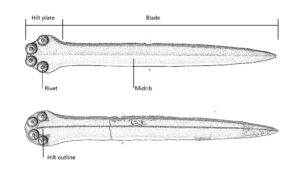The earliest sword blades in Europe are so called hilt-plate swords. These type of swords had a metal blade with a hilt plate that was attached to a grip made of organic material (wood, horn or bone). The grip was then fastened with rivets that went through holes in the hilt plate. However, the organic material has long since decayed. In general, ring rivets were used, which consist of two bronze caps on either side with a bronze pin connecting them. These rivets were attached in a trapezoid configuration with some variation in the trapezoid shape. Occasionally, evidence of the hafting can still be visible from the hilt outline that is left behind due to differences in corrosion. In rare occasions, wood remains of the grip are preserved in the corrosion.


Image 1 (left): Hilt-plate blade terminology; Image 2: Examples of the hilt cut out and trapezoidal rivet configuration. Drawings after: Laux, F. (2009) Die Schwerter in Niedersachsen. Prähistorische Bronzefunde, Band 17 (IV). Stuttgart: Franz Steiner Verlag.
Main blade types: Sögel, Wohlde, Baven and Harburg
The Sögel and Wohlde blades are the most relevant types for this project, which are described as short swords, long daggers or dirks in the literature. Their lengths range from 25 to 40 cm, but in reality, the objects were longer as an organic grip was attached to wield them. The main distinction between the two types is the shape of the hilt plate and how the blade segment transitions to the hilt plate, which is more gradual for the blades of the Sögel type. Type Sögel has a round hilt plate whereas the hilt plate of the type Wohlde typically has a trapezoid shape. Additionally, the blades of type Sögel tend to be decorated with V-shaped grooves that can be accompanied by dotted lines or garland decorations, while Wohlde shows no decorations. Beyond these two types, there are shorter dagger-like versions of the Baven and Harburg types. Type Baven is similar to type Sögel due to its round hilt plate, whereas type Harburg is similar to type Wohlde with a trapezoid hilt plate. The main distinction for these types is that they were shorter and they were hafted with peg rivets instead of ring rivets, which, in some occasions can be oversized.